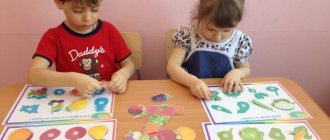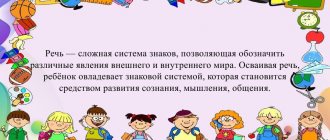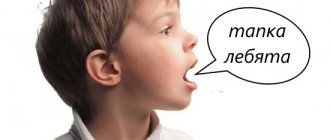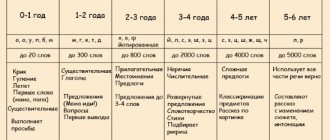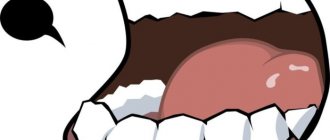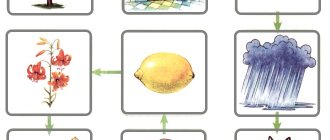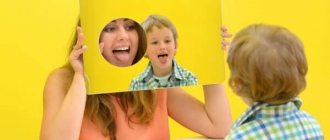Differentiation of sounds in the speech of children in speech therapy classes
Olga Khusyainova
Differentiation of sounds in the speech of children in speech therapy classes
Correct speech is important for a child's development. Of particular importance is correct sound pronunciation and perception when entering school. One of the reasons for the failure of primary school students in the Russian language is the presence of pronunciation deficiencies in children . Children who cannot distinguish and identify sounds by ear have difficulty mastering literacy.
This means that the most important prerequisite for successful learning to read and write is the ability to hear individual sounds in a word , separate them from those nearby, distinguish one sound from another by acoustic characteristics and analyze the entire sound composition of the word .
Work on differentiation of sounds should be in the following directions: develop auditory differentiation , consolidate pronunciation differentiation , form phonemic analysis and synthesis.
Differentiation of mixed sounds includes two stages:
1) stage of preliminary work on mixed sounds
2) auditory and pronunciation differentiation of mixed sounds .
First stage. It is necessary to clarify the pronunciation and auditory images of each mixed sound. The work should be carried out according to the following plan:
1). Clarify the articulation of sound , paying attention to visual, auditory, tactile perception, and kinesthetic sensations. Ex: you should monitor how the sound and at the same time clarify the correct articulation of the sound . Thanks to tactile sensations, it is necessary to clarify what kind of air stream is formed when pronouncing a differentiated sound , and to clarify the state of the vocal folds. For example, when pronouncing the sound [b], the lips are closed and opened under the pressure of exhaled air; the tip of the tongue moves slightly away from the lower teeth; flat tongue (use speech profile)
.
With the help of tactile sensations, the work of the vocal folds is clarified (they vibrate, resulting in the formation of a voice)
.
Children are given an auditory image of the sound [b] - it is compared to a loud, ringing sound , reminiscent of a stick hitting a drum.
The auditory image is reinforced by the visual perception of a picture-symbol with a drum pattern. 2). Isolate a sound against the background of a syllable . The children try to recognize the sound of a syllable by ear and in pronunciation, to distinguish between syllables with and without a given sound . Ex: when the speech therapist pronounces syllables with and without the required sound , the children will have to, upon hearing the desired sound , clap their hands ( “Who is more attentive?”
)
3). To develop the ability to highlight the presence of sound in a word . Ex: The speech therapist names words that have the desired sound and those that do not. Children must determine by ear whether a given sound . You cannot name words that contain sounds that are similar in acoustic properties.
4). Determine the place of a sound in a word : at the beginning, in the middle, at the end of the word, after which sound , before which sound .
5). Select words with a given sound from a sentence or text.
According to these instructions, you need to practice each mixed sound .
At the 2nd stage, it is necessary to compare specific mixed sounds in pronunciation and auditory terms. to differentiate sounds sound are clarified . However, the main goal is to distinguish them, so the speech material includes words with mixed sounds .
Tasks are used with well-known pure tongues and poetic works - dialogues and poems that are rich in the sounds , entertaining and accessible, and, in addition, diverse in intonation characteristics (interrogative and exclamatory)
.
Tasks for composing phrases and poems contribute to the development of rhythm, a sense of consonance, and rhyme. Children usually enthusiastically accept the speech therapist’s to compose or correct pure sayings or poems that for some reason the characters in the plot do not succeed in. First they suggest individual words and rhymes, and then whole phrases.
It is very important to differentiate phonetically similar sounds : hard and soft, voiced and voiceless, whistling and hissing, affricates and the sounds included in their composition. The sounds should be differentiated in the following sequence: B - P, D - T, G - K, Z - S, Zh - Sh, S - Sh, Z - Zh, C - S, Ch - T, Ch - Shch.
During the differentiation of sounds, the development of phonemic analysis and synthesis plays an important role; this is an important aspect at the stage of differentiation .
When forming complex forms of phonemic analysis, it is necessary to take into account that every mental action goes through certain stages of formation, the main of which are the following: mastering the action based on materialization, in terms of loud speech , transferring it to the mental plane (according to P. Ya. Galperin)
.
Stage I – formation of phonemic analysis and synthesis based on auxiliary means and actions.
The initial work is carried out based on auxiliary means: a graphic diagram of the word and chips. As sounds , the child fills in the diagram with chips. The action that the student performs is a practical action to model the sequence of sounds in a word .
Stage II – formation of the action of sound analysis in speech terms. Reliance on the materialization of action is excluded, the formation of phonemic analysis is transferred to the speech plane. The word is named, the first, second, third, etc. sounds , and their number is specified.
Stage III – formation of the action of phonemic analysis in mental terms. Children determine the number and sequence of sounds without naming the word and without directly perceiving it by ear, i.e., based on ideas
Language analysis and synthesis is complex mental work that is carried out in every lesson . Tasks are introduced in different parts of the lesson - where it will arouse the greatest interest among children .
Of particular interest to children are tasks in which scattered
sounds are “collected” or , conversely, they are “scattered”
, accompanied by action.
Compiling word schemes from color symbols alternates with selecting or searching for suitable words for a given scheme. At later stages of work, children solve puzzles and crosswords. At the same time, it is important to teach children to independently ask questions about sounds , syllables and words. Children perform creative tasks - ask questions to the characters in the lesson , each other and the speech therapist . intentionally made by the speech therapist in answering these questions arouse particular interest in children ; they respond emotionally, wanting to help correct the mistake and find the correct answer.
To prevent dyslexia and dysgraphia, each sound during work is associated with a specific letter.
For this purpose, I have developed, collected and used didactic material, which involves the use of most analyzers. Children are offered pictures-symbols. For example, to compare the sounds [b] - [p] I show pictures: the first one shows a drum with sticks in the form of the written letters b. Children, pronouncing the sound [b] , use the back of their hand to check whether the vocal folds are involved in the formation of the sound . At the same time, students are convinced that the sound [b] is sonorous and compare it with the sound made when hitting the drum with sticks.
The second picture shows a spider with legs in the shape of the written letters p. By pronouncing the sound [p] , children check the functioning of the vocal folds and make sure that the sound is dull . They associate the sound
Other sounds , where [g] is associated with the loud sound made by a goose, [k] - with the silent movement of a cat, [v] - with the loud croak of a crow, [f] - with the dull hoot of an eagle owl, [z] - with the ringing the squeak of a mosquito, [s] - with the howling of the wind, [d] - with the blows of a woodpecker on a tree trunk, [t] - with the silent movement of a cockroach, [g] - with the sound made by a flying beetle, [w] - with the dull hiss of a snake .
In addition, each letter takes on a specific image so that the child develops not only auditory, but also visual associations.
Thus, at each stage of correctional work on the formation of correct sound pronunciation , work on differentiation of sounds . It is the work of differentiating speech sounds that contributes to the child’s development of skills and abilities to accurately use previously defective sounds in any situations of speech communication.
Stage of differentiation of mixed sounds
This stage is absolutely necessary in the case of sound substitutions and mixtures of sounds, which is most typical for sensory functional dyslalia. The fact is that in such cases, even after mastering the normal articulation of a sound, the child, along with it, continues to use the previous substitute in speech, that is, mixes both sounds.
Speech therapy work on differentiation of sounds is carried out in the following directions: development of auditory differentiation, consolidation of pronunciation differentiation, formation of phonemic analysis and synthesis.
In the process of developing sound differentiation, tasks for simulating syllables are presented. For example, when differentiating s-z, such series of syllables as sa-za-sa, za-sa-za, etc. are proposed. An effective method of work is to determine the phonetic correctness of the word. Children are offered words and asemantic sound combinations, distinguished by phonetically similar sounds: ring - kolso, swallow - swallow
etc. The task is given to determine whether the word is named correctly.
Speech therapy work on differentiating specific pairs of mixed sounds includes two stages:
1) a preliminary stage of work on each of the mixed sounds;
2) the stage of auditory and pronunciation differentiation of mixed sounds.
At the first stage, the pronunciation and auditory image of each of the mixed sounds is sequentially refined.
The work is carried out according to the following plan:
1) clarification of sound articulation based on visual, auditory, tactile perception, kinesthetic sensations;
2) highlighting the sound against the background of a syllable, word, determining the place of the sound being practiced.
At the second stage, a comparison of specific mixed sounds is carried out in pronunciation and auditory terms. Much attention is given to the development of phonemic analysis and synthesis.
The sequence of differentiation of sounds at this stage is the same as at the automation stage - starting from syllables and ending with coherent speech.
The requirements for the selection of speech material here are directly opposite to its selection at the automation stage. All material must be saturated not only with the newly raised sound, but also with the sound mixed with it (the former substitute). For example, when differentiating the sounds S and Sh, the phrases used are “Sasha has a hat with ears,” “In the pine forest, resinous pines rustle and rustle.” " and so on.
This stage must be carried out especially carefully, until the complete disappearance of sound substitutions in the child’s oral speech. since this is at the same time a prevention of acoustic and articulatory-acoustic dysgraphia (or a necessary link in overcoming it, if we are talking about school-age children). In this case, work is carried out until the corresponding letter replacements in the letter completely disappear).
Features of speech therapy work on the correction of pronunciation disorders of various groups of sounds
Whistling sounds
Normal articulation of whistling sounds
Normal articulation of sounds s, s, z, zъ
The lips are stretched in a half smile; the teeth are at a distance of 1-1.5 mm, the tongue is wide. the tip of the tongue is lowered downwards and is located at the base of the lower incisors, the back of the tongue is curved, and a groove is formed in the middle of it. The passage of a stream of air through the groove causes a specific sharp noise, similar to a whistle. The lateral edges of the tongue are raised and adjacent to the inside of the upper teeth. The soft palate is raised and closes the passage into the nasal cavity. When pronouncing the sound s, the vocal folds are open; when pronouncing the sound s, they are closed and vibrate. When pronouncing the palatalized s, z
the front part of the back of the tongue becomes more curved, the longitudinal depression in the form of a groove is destroyed, the middle part of the back of the tongue is raised upward more than when pronouncing “s” and “z”.
Normal articulation of the sound ts
When pronouncing the sound ts, the lips, teeth, palatine curtain, and vocal folds are in the same position as when pronouncing the sound s.
in the articulation of the sound
ts
:
Stage 1 - the tip of the tongue is lowered down, rests against the lower incisors, the back of the tongue is sharply curved and its front part forms a bow at the necks of the upper incisors.
Stage 2 - the front part of the back of the tongue, after the explosion, moves away from the necks of the upper incisors, forming a gap; a groove is formed in the middle of the tongue.
Let's together teach children to speak clearly and correctly, easily and beautifully!
Contained in sections:
- Letters. Getting to know letters and sounds 2660
- Speech therapy classes 9273
- Literacy training. Sounds, letters, syllables 8838
Includes sections:
- Differentiation, automation of sounds. Didactic games 374
- Sounds [L] - [R]. Differentiation of sounds 157
- Sounds [L], [L']. Automation, sound differentiation 696
- Sounds [S] - [Sh]. Differentiation of sounds 437
By groups:
- Senior group
- Preparatory group
- Middle group
Showing publications 1-10 of 3964. All sections | Sound differentiation and automation
New
Photo
The best
Summary of a speech therapy lesson on automation of sounds [Р] and [Р'] Summary of an open speech therapy lesson on automation of sounds [р] and [р'] . Prepared by: teacher-speech therapist Safonova K.D. With. Shiloksha, 2021 Goals: automation of sounds [р] and [р'] in syllables , words and sentences, formation of knowledge, skills and practical skills of safe...
Abstract of an individual speech therapy lesson “Differentiation of sounds [s] - [w]” Topic: sounds [s] and [sh] . Goal: differentiation of sounds [s] and [sh] at the beginning , middle and end of a word. Objectives: 1. Development of the ability to distinguish sounds [s] and [w] at the beginning , middle and end of a word; 2. Clarification of articulation and characteristics of sounds [s] and [sh] ; 3. Development of phonemic…
